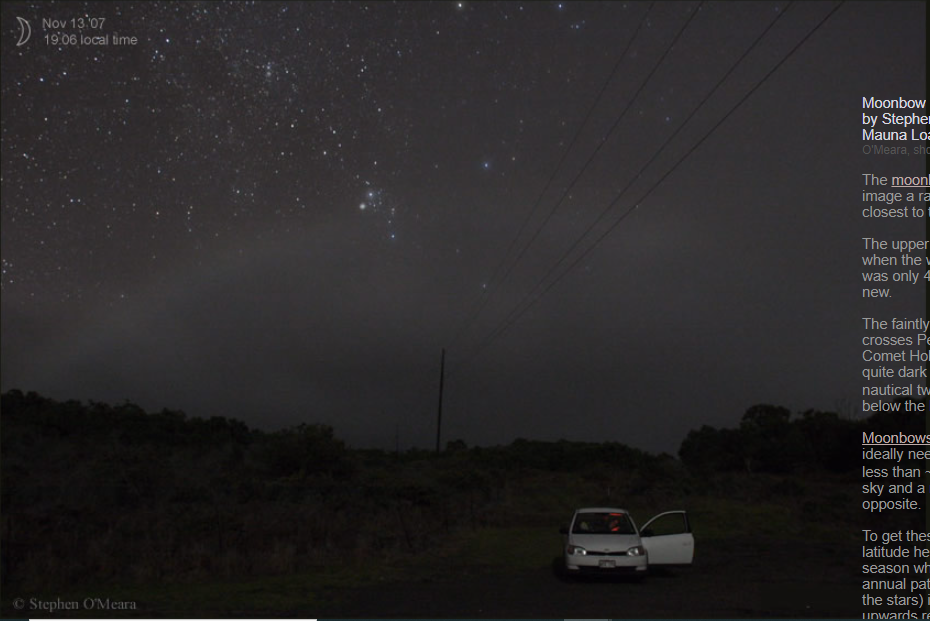Moonbow Challenge - 4 days 6 hours
Moonbow Challenge: Capturing the Elusive Rainbows of the Night Sky
Have you ever heard of a moonbow? Unlike its daytime counterpart, the rainbow, a moonbow is a rare and captivating phenomenon that occurs when moonlight interacts with raindrops in the atmosphere. It is a stunning display of colors that can leave anyone in awe. But capturing a moonbow on camera is no easy task. In fact, there is a moonbow challenge that challenges photographers to capture a rain-generated bow closest to the New Moon. The current record stands at 4 days and 6 hours after the New Moon, but will there be any challengers?
The Conditions for Moonbows
To capture a moonbow, several conditions must align perfectly. Firstly, a bright moon is needed, ideally one that is less than ~35° high in the sky. Secondly, a dark sky is crucial to ensure that the faint colors of the moonbow are visible. Lastly, a rain shower opposite to the moon's position is necessary for the moonlight to interact with the raindrops and create the bow.
To increase the chances of encountering these conditions, certain factors come into play. Low latitudes are more favorable for moonbows, as are seasons when the ecliptic (the annual path of the sun across the stars) is tilted upwards relative to the horizon. The moon's position above or below the ecliptic also plays a role in determining the likelihood of witnessing a moonbow. Moreover, weather conditions need to be just right, with frequent showers interspersed with clear skies.
Ideal Locations for Moonbows
While moonbows can potentially be seen in various parts of the world, certain locations are more renowned for their favorable conditions. Hawaii, with its dark skies and frequent rain showers, is a popular destination for lunar and solar rainbows. The Scottish Highlands and Isles, as well as Northern Ireland, also offer promising opportunities for capturing these ethereal phenomena. These regions are known for their unpredictable weather patterns and stunning landscapes, making them perfect for moonbow enthusiasts.
The Moonbow Challenge
The moonbow challenge is an exciting endeavor that pushes photographers to their limits in capturing the elusive beauty of moonbows. The previous record stood at 7 days and 14 hours after the New Moon, but recently, it has been shattered by an astonishing achievement of 4 days and 6 hours. This remarkable feat highlights the dedication and perseverance of photographers who are constantly striving to push the boundaries of their craft.
Tips for Photographing Moonbows
If you're up for the moonbow challenge or simply wish to capture the magic of a moonbow on camera, here are some tips to enhance your chances of success:
- Plan your shoot around the New Moon phase when the moon is at its faintest.
- Research locations with low light pollution and a higher likelihood of rain showers.
- Check weather forecasts for a mix of showers and clear skies.
- Use a tripod to stabilize your camera and prevent blurring.
- Experiment with different exposure settings to capture the subtle colors of the moonbow.
- Consider using a wide-angle lens to capture the expansive beauty of the night sky.
Remember, patience is key when it comes to photographing moonbows. These rare phenomena require perfect timing and a touch of luck. So, embrace the challenge, explore new locations, and let your creativity soar as you strive to capture the ethereal beauty of moonbows.
In Conclusion
Moonbows are a mesmerizing spectacle that can transform the night sky into a canvas of colors. The moonbow challenge pushes photographers to capture these elusive rainbows closest to the New Moon, resulting in breathtaking images that showcase nature's wonder. With the right conditions, careful planning, and a dash of luck, photographers can immerse themselves in the captivating world of moonbows and create stunning visual masterpieces that leave viewers in awe. So, will you take on the moonbow challenge and chase after the perfect shot? The possibilities are endless, and the beauty of moonbows awaits those who dare to capture them.

Moonbow Challenge: Bows by Stephen O'Meara at Mauna Loa, Hawaii. ©Stephen O'Meara, shown with permission.
The moonbow challenge is to image a rain-generated bow closest to the New Moon.
The upper image was taken when the waxing crescent was only 4 days 6 hours after new.
The faintly coloured bow crosses Perseus and shows Comet Holmes. The sky was quite dark at the beginning of nautical twilight (sun 12� below the horizon).
Moonbows are rare. They ideally need a bright moon less than ~35� high, a dark sky and a rain shower opposite.
To get these conditions a low latitude helps, as does a season when the ecliptic (the annual path of the sun across the stars) is strongly tilted upwards relative to the horizon. The moon's position above or below the ecliptic also counts. As for the weather, we need frequent showers interspersed with clear skies. Weatherwise, Hawaii, the Scottish Highlands and Isles and Northern Ireland are favoured places for lunar and solar rainbows.
The previous record was 7days 14 hours. Now we have 4 days 6 hours! Any challengers?

Note: this article has been automatically converted from the old site and may not appear as intended. You can find the original article here.
Reference Atmospheric Optics
If you use any of the definitions, information, or data presented on Atmospheric Optics, please copy the link or reference below to properly credit us as the reference source. Thank you!
-
<a href="https://atoptics.co.uk/blog/moonbow-challenge-4-days-6-hours/">Moonbow Challenge - 4 days 6 hours</a>
-
"Moonbow Challenge - 4 days 6 hours". Atmospheric Optics. Accessed on November 25, 2024. https://atoptics.co.uk/blog/moonbow-challenge-4-days-6-hours/.
-
"Moonbow Challenge - 4 days 6 hours". Atmospheric Optics, https://atoptics.co.uk/blog/moonbow-challenge-4-days-6-hours/. Accessed 25 November, 2024
-
Moonbow Challenge - 4 days 6 hours. Atmospheric Optics. Retrieved from https://atoptics.co.uk/blog/moonbow-challenge-4-days-6-hours/.